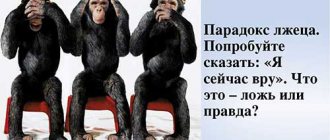Today you can observe a great variety of methods of healing, healing and self-healing. We want to recommend one of them, which definitely won’t do any harm – this is MAC therapy. First, let's explain what this means. MACs are metaphorical associative cards. They look like pictures, usually the size of a postcard or playing card. Hence, in fact, the word “cards” in the title.
Maps usually depict people or animals, objects or landscapes, abstract patterns or situations of human interaction. When looking at an image, each person inevitably has some associations, and therefore the cards are called “associative”. Thus, each card can become a visible metaphor for the desires, anxieties, experiences or even fears of a person who has built his own association with what he saw. This explains the word “metaphorical” in the name of the cards.
What are these metaphorical associative maps for? In a nutshell, they are needed in order to understand your feelings, problems or sensations that cannot be described in the usual format or are not entirely clear even to the person himself. These cards can be used independently in self-diagnosis and self-help mode. However, more often these cards are used by professional psychologists to help the person who comes to the appointment to deal with his internal problem.
What are metaphorical cards and what are they for?
Metaphorical association cards (MAC for short) are a set of psychological pictures/postcards depicting people, animals, nature, objects, abstract events, images or words that evoke their own associations in a person.
Usually the plot of an associative map is ambiguous and does not have a precise interpretation. In the same image, different people find ways to find both positive and negative focuses, depending on the individual psycho-emotional background and depth of thinking.
In psychology, with the help of MAC, specialists want to get to the original source of the disorder - the event that caused the turning point in the patient’s life. Convincingly vivid images on the cards give impetus to the revival of events from the past. And without the past, it is difficult to understand the present and, even more so, to adjust the future. And a useful dialogue between the consciousness and the subconscious begins. It's time for them to discuss with each other :)
Projection
One of the main mechanisms of cards is the law of projection. In fact, they are a stimulus that causes associations of streams that contain information about a person’s inner world. Maps are an object onto which the projected material is applied.
Projection is a psychological process that refers to psychological defense mechanisms in which what is internally is mistakenly perceived as coming from the outside. A person attributes his thoughts, feelings, motives, character traits, etc. to someone or something, believing that he took something from the outside, and not from within him. It was first described by Sigmund Freud.
Types of MAC
Metaphorical maps are divided into thematic types. There are highly specialized images designed to understand a specific complex issue, and there are quite universal postcards that can probe a vast problem area in the subconscious.
The following types of MAC are becoming most popular among psychologists:
- Persona – a set of postcards depicting human faces with a variety of emotionally charged expressions and states;
- Tandu - a special deck of cards designed to work out and adjust relationships in a couple;
- Ecco – work with creative potential;
- Cope – healing of mental trauma;
- Saga – the formation and growth of creative thinking, imagination and creative abilities;
- Morena – activates resources and gives simple ways to become happy;
- She is a female, high-resource deck;
- OH (OH) – disclosure and concept of oneself, one’s meaning and role in the Universe;
- 1001 – meaningful fairy tales for growing imagination and filling sleepless nights;
- From the chest of the past - working with childhood fears, traumas, neuroses;
- Windows and doors - working through various dangerous conditions, searching for resources to get out of them.
This is only a small thematic part of the overall impressive volume of card association decks, which is most actively used by correctional specialists or people seeking self-knowledge.
Photo by author: RF._.studio/Pexels
Metaphor
Metaphor refers to the basic phenomenon underlying the instrument.
A metaphor is an indirect message in the form of a story or a figure of speech, a figure of speech consisting of words and expressions in a figurative sense based on some analogy, similarity or comparison. Metaphor is based on similarity or likeness, it is an analogical relationship: X relates to Y as A relates to B. To understand the meaning of a metaphor, a person must activate the right hemisphere. In addition, the unconscious will grasp the necessary meaning. Therefore, it should be remembered that metaphorical cards are such a unique opportunity to look into your own unconscious.
Researchers of various sciences (linguists, psychologists, philosophers) study metaphor. Linguists Bandler and Grinder observed the clinical work of Erickson, who often used metaphor for therapeutic purposes, and based on these observations they built their linguistically oriented understanding of the mechanism of action of metaphor.
Metaphor, according to their theory, operates on the principle of a triad, passing through three stages of meaning:
- Metaphor is the surface structure of meaning expressed directly in the words of a story.
- The surface structure activates the deep structure of meaning, which is indirectly correlated with the listener (by the principle of association).
- This in turn activates the returned deep structure of meaning that is directly related to the listener.
The approach to the third stage means that the transderivative search has begun (the listener correlates with the metaphor). The storyline itself is only a bridge between the listener and the messages hidden in the story messages, which will never reach the recipient without this invisible work of establishing the necessary personal connection with the metaphor. Once the connection is made, the interaction between the story and the awakening of the listener's inner world begins.
MAK - instructions for a psychologist
MAKs are an effective tool in the hands of a psychologist, teacher or coach and have long been successfully used in transformation games, trainings and educational lectures. With the help of cards, for example, you can easily establish relationships, organize acquaintances, develop creativity, and make choices in difficult decisions.
How do metaphorical cards work? The person pulls out a postcard at his request, looks at the image and describes his intuitive associations. The patient does not talk about himself, so he relaxes and, as it were, moves away from his own problems, releasing his painful blocks and revealing his experiences. Through associative cards, an experienced psychotherapist is able to not only discover the cause of the problem, but also pull it out of the subconscious and work on it until it is completely cured.
Psychologists' clients, especially children, love to interact with metaphorical association cards in a playful way, easily relax and clearly enjoy the process of playing associations. At the same time, a psychologist can easily get to deep-seated internal problems that a person does not suspect in himself.
Photo by author: RF._.studio/Pexels
It is a known fact that our subconscious mind resists and fears being declassified, and such a method of deep associations as MAC helps to bypass this obstacle and decipher the subjective reasons for certain behavior and emotional responses to life factors. Therefore, metaphorical associative cards are a unique method and the best assistant in psychological practice. A survey of current psychologists showed that those who have already tried the MAK tool in correctional consultations cannot imagine their work without these miracle cards!
Technique: Sincere conversation about me
Hello! My name is Zateya. I am 33 years old. 5 of them I work as a psychologist-consultant in one of the Moscow centers. I received my psychological education at the Peoples' Friendship University of Russia at the Department of Psychological Counseling. But by basic education I am a chemical technologist of oil and fuel. I'm not married, no children. In my free time I dance hustle and attend the Muay Thai section. I love science fiction, and worked as a television screenwriter for a couple of years.
This is roughly how I would talk about myself if I came to you for a consultation as a client.
After what you have learned about me, do you think I will be able to pay for your services? Am I committed to solving my personal problems or do I simply have no one to complain to? Should you even try to help me or is it better to refer me to a psychiatrist?
Agree, if you were a psychologist, and I was your client at the first consultation, from my presentation above you would not understand anything really important about me.
This is exactly what the vast majority of people’s stories about themselves are like. The material that we consciously give out is often false, incomplete, consists of social cliches (studied, married, worked) and does not carry much value for a psychologist.
But not always. Now I will try to tell about myself using metaphorical cards. The specific technique I use for this is called “Honestly Talking About Me.” I always use it at the first session to get to know a new client, explain to him how the cards work and change his internal state to a more interested and open one.
How to work with metaphorical cards yourself
When a person decides to seek psychotherapeutic help and begins to work with metaphorical cards, he mentally forms his questions.
When independently exploring the subconscious, it is not so easy to formulate your request. Methods of interaction and exercise with MAC can be specific depending on the use of a particular deck.
For this action, there are two popular strategic therapeutic techniques:
- Open. The deck of metaphorical cards is arranged with the images facing up. The psychologist asks a question, and the patient chooses a picture that most accurately reflects his current state. This is a safe and completely controlled technique, focusing on a relaxed state and reducing emotional anxiety.
- Closed. Random “blind” selection of cards. This technology is based on working with the deep subconscious, and the patient intuitively reacts to the result of the choice as if it were a fateful message from above. This method gives the whole work a unique sense of intense intrigue, but can significantly increase the patient's anxiety. Psychotherapists use this MAC method after mastering the first open method.
If you are honest with yourself and fearless, go for it! You can try to combine the roles of patient and therapist and practice working with cards.
Homework
Perform the “Sincere conversation about me” technique with 5 different people.
If you don’t have a deck, you can use the free service on our website “Metaphorical Cards Online”: https://online.metaforicheskie-karti.ru/ It allows you to use the Oh-Pictures deck in online format for layouts directly on your computer screen. It looks like this:
It's not difficult to figure it out. Cards are dragged onto the table with the mouse pointer. They can be flipped over, chosen blindly, face up, enlarged, shuffled, placed anywhere on the screen - everything is as if the deck is in your hands.
Sit your loved ones and friends next to you at the screen and practice the technique.
The only negative is that the service does not yet work very well on mobile devices. But we are working on it.
Decoding the meanings of metaphorical cards
Now that we know about the ways of using metaphorical cards in professional and everyday practice, the main question arises: how to learn to “unpack” a card, how to understand what exactly it conveys?
To begin, draw a card from the deck, try to completely abstract yourself from the depicted plot and, trying to trust only your own intuition, answer yourself three simple questions:
- What exactly am I seeing? Try to break the picture down into individual objects and particles. Try to be attentive to all, even the most insignificant, details. Describe the shape, size, color, properties and methods of arrangement in the spatial perimeter. Remember, every little thing can make a difference.
- What do I think about this? At this point, try to understand how exactly the apparent purpose of these objects in the real world might relate to your individual past, present, future, or specific question being asked.
- How am I feeling right now? At this point, the kingdom of logic came to an end. Turn it off as much as possible, give free rein to your intuition and feelings. Listen to yourself and try to comprehensively evaluate the whole picture and grasp the full range of your emotions - joy or dejection, smile or sadness, tension or grace. Everything is important.
Be sure to describe all your feelings and thoughts on paper. Take notes on everything that comes to mind. Let go of your imagination - it has long deserved “free sailing” and “fair wind”. Tell your own stories about fictional characters. Unlock all the codes of intricate images to get answers to your questions. The most important thing is to become an AUTHOR and want to write your own work exactly the way and in the way that only you want.
Dissociation
An important role in the work of the tool is also associated with the feeling of security that manifests itself in a dissociated state.
Dissociation is a mental process that relates to psychological defense mechanisms. A person begins to perceive what happens to him as if it happened not to him, but to someone else. This “dissociated” position protects against excessive, unbearable emotions. A dissociated state is a state in which a person feels outside the event, looking at it and listening to it from the outside.
The client interacts with the card (talks about the characters and develops the plot) and retains a sense of magic and unreality. On the one hand, this gives him confidence in safety, and on the other hand, it stimulates active search and self-disclosure.
Use as therapeutic catalysts
A psychologist's metaphorical maps, as a tool, help initiate processes of trust, unification and safe communication between therapist and client in individual or group processes. When used, the therapeutic contract is based on the mutual understanding that any interpretation of the cards exists only in the eyes of the participants. The role of the therapist is to raise questions that clarify aspects of the process, such as: “When you are faced with a crisis, what helps you? What worries you? Who can help you? Who's bothering you? How would you end your story?
Insightful, guiding questions play an important role in the process of “joining and leading” (Erickson, 2006). “Joining” allows the therapist to connect with the client using empathy, respect and acceptance, while “leading” is the introduction of new ideas that provide alternative paths or solutions to problematic issues. This process develops within the “safe space” of the images and symbols presented in the cards. Metaphorical maps help create a “safe space” in which the client feels free and can move from areas of pain to areas of healing in a relatively short period. This space can be concrete or imaginary. It can be located indoors (castle or cave) or outdoors (field or forest). Clients can choose themselves or play one of many different roles: realistic, desired, imaginary, etc.
What decks exist and how to choose yours
The basic and main set are OH, Persona and Saga, the rest of the decks are considered narrowly focused. These decks are used for issues that require more detailed study.
Fairy-tale metaphorical cards are published for working with children.
There are a great variety of decks of cards for working with different problems, situations, with different categories of people. Each deck of cards must come with instructions for its use.
Decks are classified as follows.
By school
- Russian;
- Ukrainian;
- German;
- Israeli.
By execution
- Drawn;
- photo decks.
By content
- Images;
- Words;
- Pictures + words.
By application
- Universal;
- portraits;
- resource;
- special.
Cards are easy to buy on Ozone or Wildberries. just look at the pictures and choose what you like that resonates.
If you don’t know which area your problem belongs to, choose a universal deck, it definitely won’t hurt. Perhaps, over time, you will understand which deck is right for you.











